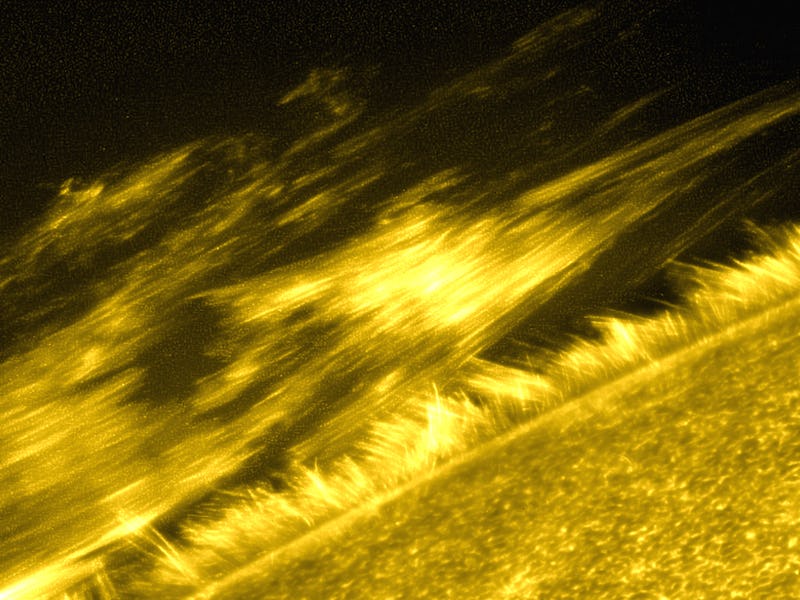Scientists want to create a 'Sun clock' to predict space weather
The clock will switch on and off periods of solar activity.

By now, scientists have gotten pretty good at forecasting weather. On any given day, we know whether or not it will rain, shine, or be cloudy.
However, when it comes to space weather, which is controlled by the flareups of the Sun that are ejected into outer space, things have been fairly unpredictable until today.
A team of scientists is attempting to help predict these solar storms by identifying patterns in the Sun's activities based on 200 years of observations. Their solution; a 'Sun clock' that predicts the Sun's on and off periods of solar activity.
The study was published this week in the Geophysical Research Letters.
What is space weather?
The Sun periodically ejects boiling-hot plasma, in the form of solar flares and solar wind, across the Solar System. These ejections cause magnetic storms in the Earth's upper atmosphere, which can have major effects on the power grids on Earth, as well as orbiting spacecraft and astronauts.
Although the effects of solar radiation on space travel are not fully understood just yet, scientists are working towards figuring out how it affects the health of astronauts. What we know so far is that space radiation pierces through molecules of DNA, altering or permanently damaging them, according to NASA.
Therefore, being able to predict when these solar storms take place could potentially protect astronauts from fatal consequences as space agencies set their sights on longer-duration missions to the Moon and Mars.
Down on Earth, we're not entirely protected from these solar storms either. When these solar flares reach Earth, they penetrate through Earth's protective layer of the atmosphere, known as the magnetosphere, and wreak havoc on our electric equipment and power grids.
On August 7, 1972, a massive solar storm erupted from the Sun's surface, disrupting radio waves, telecommunication networks, and power systems by triggering an intense magnetic storm on Earth.
A ticking clock
In order to help predict these sort of events, the scientists behind the new study mapped the Sun's activity over 18 solar cycles to a standardized 11 year cycle or ‘clock.’
The Sun clock will display the highs and lows of solar activity.
Every 11 years, the Sun embarks on a new solar cycle and we are currently on cycle 25.
The Sun's activity starts increasing halfway through the cycle and that means more solar flareups and outflow of radiation from our host star. However, as this solar cycle winds down, the Sun becomes less active.
And the Sun's activity is measured by its sunspots.
Sunspots are dark spots that mark the Sun's surface. They are caused by the magnetic field inhibiting the transfer of energy on the surface of the Sun through the process of convection, where hot fluid rises and cooler fluid sinks.
Halfway through its cycle, when the Sun is most active, the most amount of sunspots can be seen across its surface.
Therefore, the researchers turned to these elusive dots to devise their Sun clock. They used the sunspot number record available since 1818 to map out solar activity for the past 200 years and were able to identify a pattern of transitions between the Sun's quiet and active periods.
Their observations showed a precise switch on and switch off times of solar activity.
“Scientists spend their lives trying to read the book of nature. Sometimes we create a new way to transform the data and what appeared to be messy and complicated is suddenly beautifully simple," Sandra Chapman, of the University of Warwick’s Centre for Fusion, Space, and Astrophysics, and lead author of the study, said in a statement. "In this instance, our sun clock method showed clear 'switch on' and 'switch off' times demarcating quiet and active intervals for space weather for the first time."
The Sun clock can be used to predict when extreme events of solar weather could take place since they tend to occur during the Sun's periods of high activity, known as a solar maximum.
“If you have a system sensitive to space weather you need to know how likely a big event is, and it is useful to know when we are in a quiet period as it allows maintenance and other activities that make systems temporarily more fragile," Chapman said.
Abstract: By obtaining the analytic signal of daily sunspot numbers since 1818 we construct a new solar cycle phase clock that maps each of the last 18 solar cycles onto a single normalized 11 year epoch. This clock orders solar coronal activity and extremes of the aa index, which tracks geomagnetic storms at the Earth's surface over the last 14 solar cycles. We identify geomagnetically quiet intervals that are 40% of the normalized cycle, ±2π /5 in phase or ±2.2 years around solar minimum. Since 1868 only two severe (aa >300 nT) and one extreme (aa >500 nT) geomagnetic storms occurred in quiet intervals; 1–3% of severe (aa >300 nT) geomagnetic storms and 4–6% of C‐, M‐, and X‐class solar flares occurred in quiet intervals. This provides quantitative support to planning resilience against space weather impacts since only a few percent of all severe storms occur in quiet intervals and their start and end times are quantifiable.